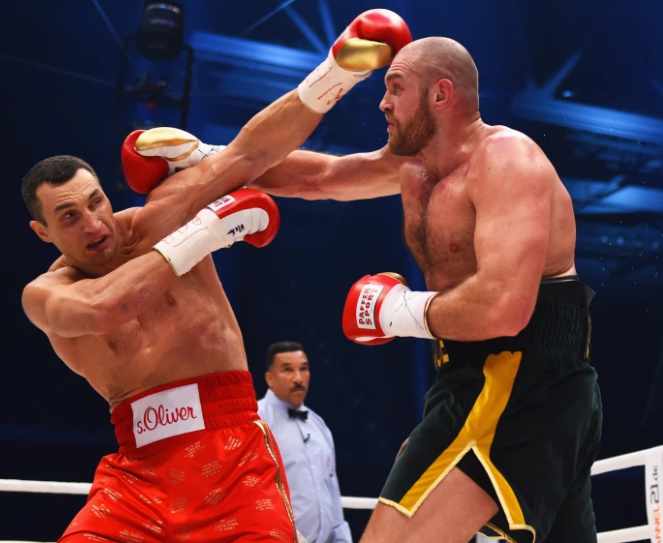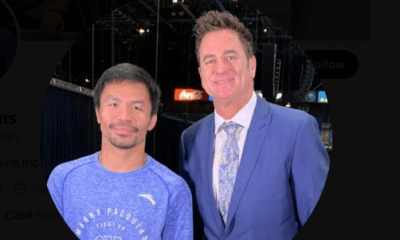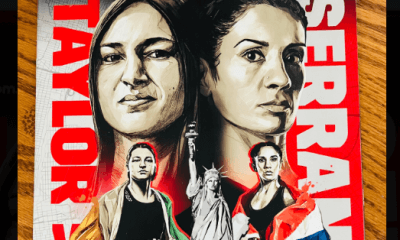Featured Articles
Re-Visiting The Fury – Klitschko Fight: A TSS Classic

DUSSELDORF, A FURY WONDERLAND – Is it too far a stretch to envision Tyson Fury as the boxer to assume Money Mayweather’s mantle? Not as far today as many people, including myself, thought it was, going into ESPIRIT Arena on a rainy Saturday evening.
It will take many moons to assess Fury’s subsequent historical status, but for now we must say he is a man of his word. Some big heavyweight title upset winners like Clay / Ali (vs Liston) or Foreman (vs Moorer) went on to far greater things. Some, like Douglas (vs Tyson) or McCall (vs Holmes) not so much.
It appears we can count on Fury to keep things interesting and straightforward. He has recently been praising conservative Christianity more than he has been praising himself, so sparks seem guaranteed to fly.
If contact with his longtime promoter Mick Hennessey indicates anything, the team has strong ethics to go with Fury’s outrageous controversial side.
While the fight was definitely not a classic, or even a very stirring battle, I disagree with those who proclaimed it a putrid display of the sport. Whatever Fury does next, his detractors don’t seem to understand what he was doing, by design, against Wladimir Klitschko.
It was a classic scene and performance in significance alone. Fury achieved something classic in sport in becoming an unlikely underdog victor against a longtime, respected champion.
I saw this one coming about as much as Klitschko seemed to see Fury’s jab, chin or body. While I was way off on what I predicted would happen, I did recognize it when it arrived. Fury had made the same shifting feints during training, I just figured Klitschko would eventually back him up and go to work.
Instead, Fury implemented a plan he steadfastly hinted at. It seemed pretty clear by the third round Fury was doing exactly what he’d promised, capturing Klitschko’s multiple heavyweight titles plus some of his prestige, with what appeared to be exactly as easy a victory as predicted. I saw it 118 – 111, and to sourpusses who squawk that Klitschko looked terrible I say Fury made him look that way and deserves credit.
The stormy Rhineland was sparkling from Christmas markets and the glowing faces of UK revelers. “Walking in a Fury Wonderland” got bellowed past dawn by dozens of drunken British visitors in the old town area. It is still going on somewhere.
The blokes did heed Michael Buffer’s call to remain quiet during the national anthems. I didn’t see that coming either. Besides, Fury earned a few serenades, and even sampled a heartfelt tune to his wife after choking up in a tribute to his team.
Fury looked like he was in a hyper-state of concentration heading into the ring. He charged out, not really throwing punches as much as establishing space and movement. Fury confused Klitschko with feints and short punch series that made just enough openings for Fury to take close, uneventful rounds. He built a lead and never looked back.
The second half of the bout got ugly, with frequent mutual clutches. The amount of times somebody ended up clinching from behind showed how sloppy things became, but it was still a long time since a Klitschko fight progressed with the outcome in doubt, so tension rose and there was a subtle excitement in the stands.
By the midway point, Klitschko needed to do something dramatic but it was Fury who just kept throwing. Whether Fury landed hard or clean didn’t matter. At least he was landing something and Klitschko’s corner looked worried as he was getting busted up.
Klitschko was aggressive much of the time, but he was never effective and after the ninth frame he looked uncertain. Fury looked extremely confident and kept Klitschko from finding any rhythm. When Klitschko did land a rare, decent punch, Fury shrugged it off.
When Fury lost a point in the eleventh for mauling and hitting behind the head, there was a tinge of mass anticipation, but overall ref Tony Weeks did a good job of controlling some messy collisions and was not an interfering factor. “I didn’t think I’d get the decision after that,” Fury said afterward.
Fury hurt Klitschko with lefts and had a cut Klitschko in big trouble on unsteady legs as the fight concluded. The crowd was screaming, and most of them were screaming for Fury as Klitschko hung on. The only thing sad about Fury’s victory was that it probably detracts from Klitschko’s legacy.
Klitschko reminded people that he has four fights left on his TV contract, including a rematch. “We do not know where or when but there will definitely be a rematch, it is in the contract,” said a bruised Klitschko, who still looked stunned at the post-fight conference. Expect Manchester to exert some leverage.
“I’ve just taken out Klitschko, who was number one for so long, Deontay Wilder will have to wait,” mused Fury with a wide grin. “I don’t mind fighting in Germany again, the people showed me a lot of love. Klitschko has a round two, ding, ding, ding.”
Promotional generalities indicated a rematch could occur around April or May.
That doesn’t guarantee Klitschko will continue the campaign. It looked like wife Hayden Panettiere wouldn’t mind his retirement as she gracefully answered a post-fight, big screen question on live German TV about whether or not she and Klitschko having a child had ruined his career.
Meanwhile, new champion Fury has some very big boxing shoes to fill and he sounded sincere acknowledging that. If he does get past Klitschko again or that fight doesn’t happen, think how big a UK fight against Anthony Joshua could become.
“I want to be the most colorful champion since Muhammad Ali. I want to be great, so I will take on all challengers. If I can be half the champion Wladimir was, I’ll be happy.”
Admirable goals, and if Fury is a long shot for them, well…
For now, critics of Fury, Klitschko, and the heavyweights continue to hiss. Somewhere, Klitschko touches his face and feels older, around the time Fury is posing for a photograph.
British fans who made the trip to Germany ride the last buzz of euphoria, unless that is, they made a big bet on the underdog like Fury who bet 300,000 bucks on himself.
The rain continues to fall, the fire continues to burn.
EDITOR’S NOTE: This story originally appeared on Nov. 30, 2015 under the title “Fury’s Future after Klitschko: Praise Thee Who Praise Themselves”
Check out more boxing news on video at The Boxing Channel
To comment on this story in the Fight Forum CLICK HERE
-

 Featured Articles3 weeks ago
Featured Articles3 weeks agoVito Mielnicki Jr Whitewashes Kamil Gardzielik Before the Home Folks in Newark
-

 Featured Articles4 days ago
Featured Articles4 days agoResults and Recaps from New York Where Taylor Edged Serrano Once Again
-

 Featured Articles1 week ago
Featured Articles1 week agoFrom a Sympathetic Figure to a Pariah: The Travails of Julio Cesar Chavez Jr
-

 Featured Articles3 days ago
Featured Articles3 days agoResults and Recaps from NYC where Hamzah Sheeraz was Spectacular
-

 Featured Articles4 weeks ago
Featured Articles4 weeks agoCatching Up with Clay Moyle Who Talks About His Massive Collection of Boxing Books
-

 Featured Articles1 week ago
Featured Articles1 week agoCatterall vs Eubank Ends Prematurely; Catterall Wins a Technical Decision
-

 Featured Articles4 days ago
Featured Articles4 days agoPhiladelphia Welterweight Gil Turner, a Phenom, Now Rests in an Unmarked Grave
-

 Featured Articles3 weeks ago
Featured Articles3 weeks agoMore Medals for Hawaii’s Patricio Family at the USA Boxing Summer Festival



















